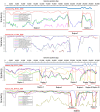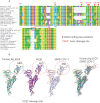Identification and genetic characterization of five novel bat coronaviruses from Yunnan, China
- PMID: 39396004
- PMCID: PMC11470664
- DOI: 10.1186/s12917-024-04310-6
Identification and genetic characterization of five novel bat coronaviruses from Yunnan, China
Abstract
Background: Coronaviruses (CoVs) represent a serious threat to human health and have become a major transmissible, endemic, and causative pathogen in humans; they represent a major health concern, given their ability to cause infectious diseases. Bats are natural hosts for diverse viruses. Many transmission events of CoVs and identification of multiple novel CoVs in bats has increased attention towards their capacity to serve as hosts for zoonotic viruses.
Results: In this study, 61 bats from Yunnan Province were analyzed, identifying seven CoVs, including three α- and two β-CoVs with full-genome sequences. Among the five identified alpha-CoVs, four belong to the Decacovirus subgenus and one to the Minunacovirus subgenus. Two beta-CoVs were also identified, both belonging to the Sarbecovirus subgenus.The genetic structures revealed similarities to known strains such as HKU10 and SARS-CoV-2, along with novel findings such as the Minunacovirus subgenus CoV YJ3c/f and unique ORF patterns. Our results demonstrated that strain JCC9 has a unique recombination pattern and shows a higher binding affinity to civet and pangolin ACE2 receptors, then the HpJC8xc strain transmits and recombines between hosts (bats), indicating a potential risk of crossing the interspecies barrier and infecting other animals.
Conclusions: The CoVs detected in the bats studied in this research exhibit high diversity. Genomic analysis revealed that CoVs in bats undergo frequent recombination events. Furthermore, recombination patterns and evolutionary analyses suggest that alpha-CoVs are more prone to cross-species transmission across different bat families/genera, whereas beta-CoVs demonstrate host specificity and tend to co-evolve with their bat hosts.Our finding suggest that bats, as hosts of CoVs, be constantly monitored to prevent outbreaks of new infections caused by viruses passing across interspecies barriers, and consequently, viral diseases in humans or livestock.
Keywords: Bats; Characterization; Coronaviruses; Transmission; Yunnan.
© 2024. The Author(s).
Conflict of interest statement
The authors declare no competing interests.
Figures






Similar articles
-
Severe Acute Respiratory Syndrome (SARS) Coronavirus ORF8 Protein Is Acquired from SARS-Related Coronavirus from Greater Horseshoe Bats through Recombination.J Virol. 2015 Oct;89(20):10532-47. doi: 10.1128/JVI.01048-15. Epub 2015 Aug 12. J Virol. 2015. PMID: 26269185 Free PMC article.
-
Epidemiology and Genomic Characterization of Two Novel SARS-Related Coronaviruses in Horseshoe Bats from Guangdong, China.mBio. 2022 Jun 28;13(3):e0046322. doi: 10.1128/mbio.00463-22. Epub 2022 Apr 25. mBio. 2022. PMID: 35467426 Free PMC article.
-
Surveillance of Bat Coronaviruses in Kenya Identifies Relatives of Human Coronaviruses NL63 and 229E and Their Recombination History.J Virol. 2017 Feb 14;91(5):e01953-16. doi: 10.1128/JVI.01953-16. Print 2017 Mar 1. J Virol. 2017. PMID: 28077633 Free PMC article.
-
Global Epidemiology of Bat Coronaviruses.Viruses. 2019 Feb 20;11(2):174. doi: 10.3390/v11020174. Viruses. 2019. PMID: 30791586 Free PMC article. Review.
-
Ecology, evolution and classification of bat coronaviruses in the aftermath of SARS.Antiviral Res. 2014 Jan;101:45-56. doi: 10.1016/j.antiviral.2013.10.013. Epub 2013 Oct 31. Antiviral Res. 2014. PMID: 24184128 Free PMC article. Review.
Cited by
-
Molecular Surveillance for Potential Zoonotic Pathogens in Troglophilus Bats: Detection and Molecular Characterization of Bat Coronaviruses in Southern Italy.Pathogens. 2025 May 7;14(5):457. doi: 10.3390/pathogens14050457. Pathogens. 2025. PMID: 40430777 Free PMC article.
-
Comparative Analysis of Quan and Watanabe Pan-Coronavirus Assays for Bat Coronavirus Diversity in Sarawak, East Malaysia.J Med Virol. 2025 May;97(5):e70389. doi: 10.1002/jmv.70389. J Med Virol. 2025. PMID: 40358016 Free PMC article.
References
-
- The state council the people’s republic of China. https://english.www.gov.cn/statecouncil/ministries/202102/05/content_WS6.... Accessed 15th August 2024.
-
- Jiang X, Li Q, Chen Z, Zhang B, Li X, Wan T. List of Biological species in Yunnan Province (2016 Edition). Kunming: Yunnan Science and Technology Press[in China]; 2017.
MeSH terms
Grants and funding
LinkOut - more resources
Full Text Sources
Miscellaneous

